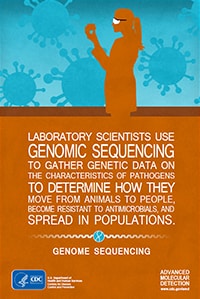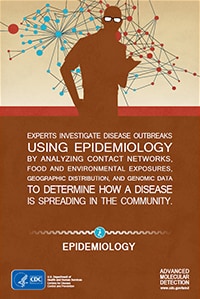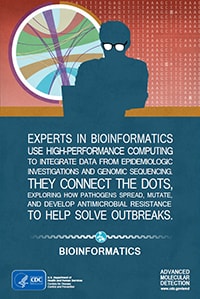Who We Are
CDC’s Advanced Molecular Detection (AMD) program is helping modernize the public health system’s disease-investigation capabilities by employing the latest technologies and improving AMD capacity throughout the nation.
Under the AMD program, CDC has been working to build on the nation’s existing public health infrastructure by integrating AMD technologies. These modern tools deliver a greater level of detailed information on infectious pathogens than older, slower, and less cost-effective methods. Since its inception in 2014, the AMD program has increased the availability of next generation sequencing and other AMD technologies within CDC and in state and local public health systems.
The AMD program works with experts across CDC to ensure the United States has the infrastructure, including technology, needed to protect Americans from infectious disease threats. The AMD office collaborates with other CDC programs to facilitate development and pilot testing of next-generation diagnostic tests and protocols. Other programs throughout CDC leverage these tools against a variety of infectious pathogens and help state and local public health agencies tap into them, as well.
Download: AMD At a Glance Cdc-pdf
The AMD program is helping build and integrate laboratory, bioinformatics, and epidemiology technologies across CDC and nationwide. Building capacity in all three areas is necessary for creating a 21st century public health detection and surveillance system to protect the United States from disease threats.
Laboratory Technologies
AMD technologies include laboratory methods to extract and sequence the DNA of pathogens, including next generation genomic sequencing (NGS) and whole genome sequencing (WGS). Sequencing technologies range from portable sequencers for field-based testing, to benchtop and full-sized sequencers for laboratory use.
Epidemiology Technologies
Epidemiologists help detect where data from their traditional field investigations intersect with genomic data to pinpoint disease outbreaks and clusters of human illnesses. Through training in molecular epidemiology, CDC is helping build on the existing epidemiology workforce, so they can use genomic data generated and analyzed through bioinformatics pipelines to help solve outbreak mysteries.
Bioinformatics Technologies
Even though infectious pathogens are small, sequencing their DNA generates a tremendous amount of genomic data. To analyze those data, experts in bioinformatics use high-performance computing systems to devise programs, often called pipelines. Once designed and validated, these pipelines can speed up detection and characterization of pathogens. By uploading DNA sequence data into a specific pipeline, scientists can rapidly find out which species or strain of the pathogen is involved in an outbreak, and specific characteristics that can be important for fighting it, such as whether it is resistant to antimicrobials.
View the full series of AMD Scientific Superhero posters.



